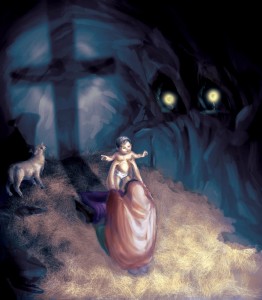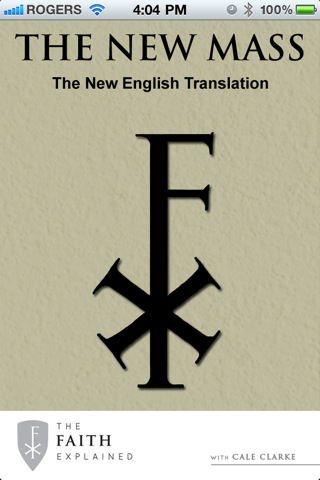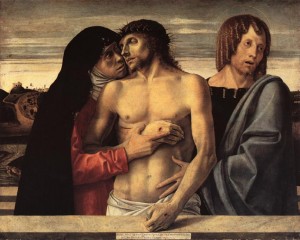 Merry Christmas from all of us at The Faith Explained!
Merry Christmas from all of us at The Faith Explained!
John’s gospel portrays Jesus as King of the Universe, and his throne is a cross. From the cross, King Jesus reigns, and he teaches. In fact, looking upon a crucifix can be a catechism unto itself. Catholics are often asked by other Christians, “Why do you always insist on placing the crucified Christ before our eyes? Don’t you know that he is risen?” Well, of course we do. The reason we place crucifixes in churches is very simple: when we behold the Lord upon the cross, we are contemplating the greatest act of love the world has ever seen. The lessons Jesus would teach from the wood of the cross were prefigured in many ways by those he proclaimed from the wood of the manger in Bethlehem.
Jesus “began to do and to teach”, even before he uttered intelligible words. He began teaching from the very moment of his conception in the womb of his Immaculate mother. When Mary, carrying our Lord in utero, approached her relative Elizabeth, who was pregnant with John the Baptizer, John leapt in the womb. The lesson was clear: being near Jesus always brings joy. And in Bethlehem, on the night of his birth, he taught us even more.
Jesus teaches us humility: the God-Man chose not to be born in a palace, but in abject poverty. No place for them in the inn, Mary gave birth to Jesus in a type of cave, where animals were kept. Ironically, the name Bethlehem literally means, “the house of bread”. The bread of life, Jesus, who would later give us his flesh and blood to consume in the Eucharist, had for his first crib a manger, a wooden feeding trough.
He teaches us detachment. It is not worldly goods that will bring us lasting happiness; it is being with Christ, even in the poverty of that first Christmas. He also teaches us not to seek the praise of men, but only the applause of heaven. The shepherds, not the elite of Jerusalem society, found Christ in the manger, even though they were considered little more than scum in the eyes of their fellow Israelites.
The infant Jesus also teaches us not to attempt to impose our opinion on others. In his second coming, no one will be able to deny the reality of Jesus as God. But at Christmas, as a helpless infant, Jesus chose to be vulnerable, able to be rejected – and he was. The reason Mary had to give birth in that cave-stable was that door after door had been shut in Joseph’s face as he sought a place for the Holy Family to stay. Those people had no room in their lives for Jesus, or the lessons he teaches. May that never be said of us.
 Today’s Gospel is the famous account of the Annunciation from Luke 1:26-38. It includes some indirect proof for two major Marian dogmas of the Church – the Immaculate Conception (which was recently celebrated on Dec. 8), and the perpetual virginity of Our Lady. It also gives us part of the biblical roots of the “Hail Mary”.
Today’s Gospel is the famous account of the Annunciation from Luke 1:26-38. It includes some indirect proof for two major Marian dogmas of the Church – the Immaculate Conception (which was recently celebrated on Dec. 8), and the perpetual virginity of Our Lady. It also gives us part of the biblical roots of the “Hail Mary”.
When the archangel Gabriel greets Mary, it marks the only recorded incident in scripture that an angel greets someone by their title, not their name. “Hail, Full of Grace, the Lord is with you” (Lk 1:28). This, of course, is the first line of the “Hail Mary”, with the second line, “Blessed are you among women, and blessed is the fruit of your womb”, from Luke 1:42. So much for the ridiculous argument that the prayer is “unbiblical”.
But what of those dogmas? Speaking of the phrase, “Full of Grace”, in the original Greek of Luke’s Gospel, it is an interesting term: “kecharitomene”. It means, literally, “one who has been made full of God’s grace” (biblical translations that render this term “highly favored one”, or something to that effect, don’t cut it) . It’s a past perfect, meaning that, at some point in the past, Mary was made perfectly full of God’s grace. This condition extends out into the future, into eternity. This is exactly what the Immaculate Conception is all about – that, from the first moment of her existence, Mary was preserved free from all stain of original sin. If one is perfectly full of the grace of God, there is no room for sin.
With respect to the perpetual virginity, Gabriel explains to Mary that she will bear the Messiah, and at this point he has said nothing about Jesus being conceived by the Holy Spirit. Yet, Mary says, “How can this be, since I am a virgin?” (Lk 1:34). A very strange question for a young woman to ask, who, as we have already been told, was engaged to be married. Unless, that is, she had already intended to remain a virgin, consecrating herself wholly to God.
 I have written elsewhere in these pages about Tim Tebow, and let me say on record that I’m a fan. To say that Tebow is the most polarizing athlete of our time is no understatement, and much of this is due to the way he articulates his faith. Robert Mixa, over at the fantastic Word on Fire blog, makes some very thought-provoking comparisons between the way Tebow speaks about his beliefs, and the new English Mass translation – both of which are making some people very, very uncomfortable. You can check it out here. Be sure to leave your thoughts in the combox below. Big HT to Jasmin Lemieux-Lefebvre (@jasminll) for alerting me to this story.
I have written elsewhere in these pages about Tim Tebow, and let me say on record that I’m a fan. To say that Tebow is the most polarizing athlete of our time is no understatement, and much of this is due to the way he articulates his faith. Robert Mixa, over at the fantastic Word on Fire blog, makes some very thought-provoking comparisons between the way Tebow speaks about his beliefs, and the new English Mass translation – both of which are making some people very, very uncomfortable. You can check it out here. Be sure to leave your thoughts in the combox below. Big HT to Jasmin Lemieux-Lefebvre (@jasminll) for alerting me to this story.
 I recently had a radio conversation with the always entertaining Pedro from Salt and Light! Our chat shed some light on the creation of The New Mass app for Apple and Android, as well as our thoughts on the new English Mass translation itself. You can listen for yourself, or download the podcast here. Spread the word!
I recently had a radio conversation with the always entertaining Pedro from Salt and Light! Our chat shed some light on the creation of The New Mass app for Apple and Android, as well as our thoughts on the new English Mass translation itself. You can listen for yourself, or download the podcast here. Spread the word!
 Matt Warner over at Fallible Blogma mentions The New Mass app for iOS and Android in his collection of new Mass resources. Check out the article here. Oh, and make sure you watch those great LifeTeen videos on the new translation!
Matt Warner over at Fallible Blogma mentions The New Mass app for iOS and Android in his collection of new Mass resources. Check out the article here. Oh, and make sure you watch those great LifeTeen videos on the new translation!
 If you attended Mass earlier today, you witnessed the end of an era. Today was the final celebration of the liturgy with the now “old” English translation of Mass, officially known as the 2nd Edition of the Roman Missal in English. Beginning tonight with the vigil Masses for the 1st Sunday of Advent, we will be using the 3rd Edition of the Roman Missal – the new English translation – in North America, and in many other English-speaking countries around the world.
If you attended Mass earlier today, you witnessed the end of an era. Today was the final celebration of the liturgy with the now “old” English translation of Mass, officially known as the 2nd Edition of the Roman Missal in English. Beginning tonight with the vigil Masses for the 1st Sunday of Advent, we will be using the 3rd Edition of the Roman Missal – the new English translation – in North America, and in many other English-speaking countries around the world.
I can’t wait to get started with the new translation. Since I created The New Mass app for iOS and Android, and have been giving all kinds of presentations explaining the new Missal, one might expect that. But I really do believe this is going to be great. Pope Benedict said when the final text was presented to him last year that he hoped it would serve as “a springboard for renewal of Eucharistic devotion all over the English-speaking world.” So, let’s dive in!
How about you? Will there be anything you’ll miss about the old translation, or is there anything you can’t wait to hear in the new? Let us know in the comments below.
 The Old Testament readings at daily Mass lately have been taken from the book of Daniel. This was a book that Jesus drew from in important ways to explain his identity. In today’s first reading, we witness Daniel’s incredible night visions:
The Old Testament readings at daily Mass lately have been taken from the book of Daniel. This was a book that Jesus drew from in important ways to explain his identity. In today’s first reading, we witness Daniel’s incredible night visions:
I saw in the night visions, and behold, with the clouds of heaven there came one like a son of man, and he came to the Ancient of Days and was presented before him. And to him was given dominion and glory and kingdom, that all peoples, nations, and languages should serve him; his dominion is an everlasting dominion, which shall not pass away, and his kingdom one that shall not be destroyed.
– Daniel 7:13-14
Many Christians are under the mistaken impression that the term “Son of God” refers to Jesus’ divine nature, while “Son of Man” (which is Jesus’ favorite self-designation in the Gospels) is a reference to his human nature. In reality, the opposite is the case. Now, don’t get me wrong – Jesus is God the Son, the unique, “only-begotten son” of the Father (cf. John 1:18, 3:16). But, in the Old Testament, all Israel was known as God’s “son” (see Hos 11:1), with individual Israelites known as the “sons of God” in an adoptive sense.
The passage from Daniel above speaks of an enigmatic “one like a son of man”, coming on the clouds of heaven, who approaches the “Ancient of Days” (God the Father) and receives an indestructible kingdom and the service of all people. This passage is quoted by Jesus when he is on trial before the high priest. At issue is his messiahship.
And the high priest stood up in the midst, and asked Jesus, “Have you no answer to make? What is it that these men testify against you?” But he was silent and made no answer. Again the high priest asked him, “Are you the Christ, the Son of the Blessed?” And Jesus said, “I am; and you will see the Son of Man seated at the right hand of Power, and coming with the clouds of heaven.” And the high priest tore his garments, and said, “Why do we still need witnesses? You have heard his blasphemy. What is your decision?” And they all condemned him as deserving death.
– Mark 14:60-64
The high priest certainly understood what Jesus meant by referring to himself as “Son of Man”. He is that figure who Daniel had envisioned so long ago – the everlasting King.
 We are thrilled to announce that The New Mass app, the #1 app for the new English translation of the Mass, is now live in the Android App Market! Click here to download it!
We are thrilled to announce that The New Mass app, the #1 app for the new English translation of the Mass, is now live in the Android App Market! Click here to download it!
We’re so happy to offer you this incredible tool for the Mass, alongside our popular iPhone app.
Our team has been working some very long hours on this one, especially the great Batsirai Chada. My hat’s off to you, big guy!
 Today’s Gospel relates a somewhat embarrassing truth about the Apostles James and John, the sons of Zebedee:
Today’s Gospel relates a somewhat embarrassing truth about the Apostles James and John, the sons of Zebedee:
When the days for Jesus to be taken up were fulfilled,
he resolutely determined to journey to Jerusalem,
and he sent messengers ahead of him.
On the way they entered a Samaritan village
to prepare for his reception there,
but they would not welcome him
because the destination of his journey was Jerusalem.
When the disciples James and John saw this they asked,
“Lord, do you want us to call down fire from heaven
to consume them?”
Jesus turned and rebuked them,
and they journeyed to another village.
– Luke 9:51-56
These two brothers were also known as “Boanerges” – the “sons of thunder”. And, no, it’s not because they had gas. It seems they had a bit of an anger problem – their passion for our Lord led them to want to “zap” those who didn’t accept him.
But Jesus knew about their faults, and called them to be his followers anyway. That’s because he knew that he could transform their faults into strengths. Francis Fernandez, in his magnificent daily devotional, “In Conversation With God”, relates an anecdote about Saint John in later life. St Jerome wrote that the aged Apostle, when speaking with his fellow believers, used to repeat, again and again, “Little children, love one another”. His listeners, perhaps a bit miffed that someone who knew our Lord personally didn’t seem to have any fresh homiletical material, asked him, “Why do you keep on repeating the same thing all the time?” John replied, “Because if we only do this one thing, it will be enough”. John’s desire to call down fire from heaven was changed to a living flame of love.
Jesus’ teaching on love being the hallmark of a Christian’s life – even for one’s enemies – eventually sunk into John’s ears, especially when he saw it in praxis at the foot of the cross, along with Mary. And when he was chosen by the Master to take care of his Mother, John no doubt was privy to even more lessons on what it means to love, from the person who knew Jesus best.
If Jesus could change this angry young man into “the Apostle of love” – his Gospel and New Testament letters are rife with this theme – imagine how Jesus can turn our weaknesses into strengths, if we stay close to him on the Way.


